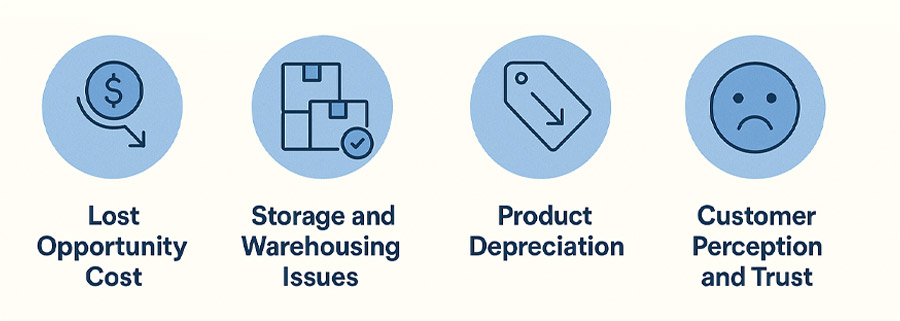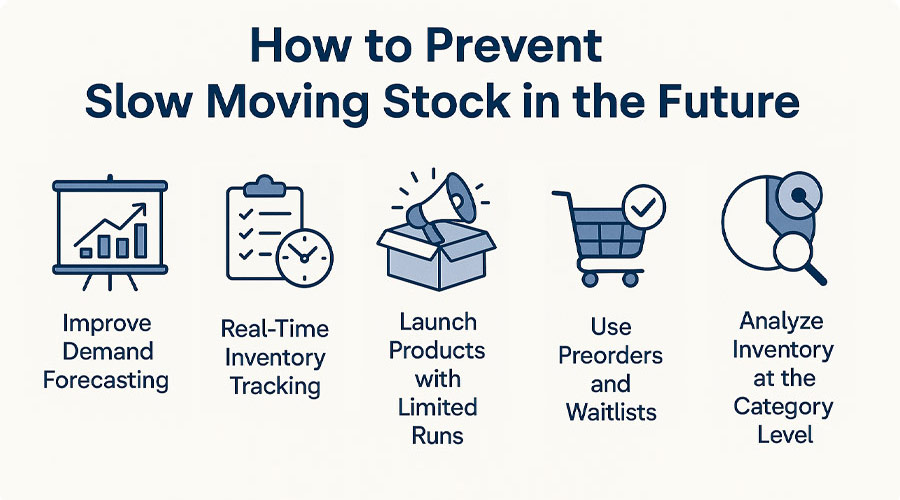Slow moving products can be a serious challenge for any eCommerce business. These are items that don’t sell as fast as expected, often ending up stuck in storage. The slow moving stock definition varies, but it generally refers to inventory that stays unsold for a long time—losing value and appeal over time.
For online retailers, slow moving stocks cause real problems:
-
Cash flow issues: Capital is locked in unsold inventory instead of fueling growth or marketing.
-
Storage costs: Whether in-house or through third-party fulfillment, unused space gets expensive.
-
Reduced agility: You’re stuck with outdated products and unable to pivot quickly.
Too much slow moving stock ties up resources and limits your ability to compete. But the good news? There are smart, actionable strategies to turn that stock into profit. Let’s dive into 30 ways to move inventory and boost your bottom line.
What Are Slow Moving Products?
Slow moving products are items that sell much slower than expected—typically sitting in inventory for 90 days or more. Based on the slow moving definition, they’re not completely unsellable but require time and effort to move. These items freeze funds, occupy storage, and slow down your business operations.
It’s important to distinguish slow moving stocks from dead stock. While dead stock is unlikely to ever sell due to being outdated or damaged, slow moving stock still has potential—it just needs the right strategy.
Slow Moving Goods Examples:
-
A less popular color or size of a fast-selling shoe.
-
A holiday-themed item still in stock months after the season ended.
These slow moving items aren’t a lost cause—but they need attention before they become dead weight.
How to Identify Slow Moving Inventory?
The first step in solving a slow stock problem is knowing what’s actually slow. Many retailers don’t realize how much of their capital is tied up in underperforming inventory until it’s too late. To avoid that, you need to track the right metrics and use the right tools.
Key Metrics to Watch
-
Days Sales of Inventory (DSI): This shows the average number of days it takes to sell your inventory. A high DSI can be a clear sign of slow moving stock.
-
Inventory Turnover Ratio: This measures how often you sell and replace inventory in a given period. A low turnover rate often points to slow moving products that aren’t generating steady sales.
-
Shelf-Life Tracking: For products with expiration dates (like food, cosmetics, or supplements), a long stay in storage compared to expected shelf-life signals slow movement—and potential waste.
Tools to Help You Spot Slow Sellers
-
Inventory Reports: Whether you use a simple spreadsheet or a full inventory management system, regular reporting helps highlight which SKUs are lagging behind.
-
POS Insights: Your point-of-sale data can reveal trends over time—products with consistently low sales volume or those that rarely get reordered.
-
Analytics Platforms: Tools like Shopify analytics, TradeGecko, or NetSuite offer dashboards to filter and track slow moving stock at a glance.
Slow Moving Products Examples You Might Miss:
-
A product with high returns and few reorders, like a trendy kitchen gadget from a TikTok trend (like a rapid chopper or avocado slicer) that turns out to be impractical. Customers return it frequently, and there are no follow-up purchases.
-
Seasonal goods that haven’t sold weeks after peak season, like christmas-themed sweaters or LED holiday lights still in stock by mid-January. These items have limited appeal once the holiday season ends.
-
Accessories tied to discontinued items (e.g., phone cases for older models), like iPhone 11 cases still sitting in inventory after Apple launches newer models like iPhone 15. As users upgrade, demand drops sharply.
Identifying slow moving products early helps you avoid overstock, protect your cash flow, and plan smarter promotions before stock turns into a liability.
30 Ways to Sell and Eliminate Slow Moving Products
If you’re wondering how to sell slow moving products without slashing your margins or wasting inventory, these 30 strategies will help. Grouped into 9 proven categories, each tactic is designed to help you move stock, recover cash, and unlock hidden value in your inventory.
Bundling and Upselling
An easy way to add perceived value is by combining products—especially when you pair slow movers with something customers already want. Here are a few practical ideas to make bundling work:
1. Create product bundles to pair slow movers with best-sellers.
2. Offer “Buy One, Get One” deals, placing the slow-moving product as the free item.
3. Bundle with complementary items, e.g., a phone case with a screen protector.
4. Cross-sell at checkout, suggesting slow moving stock items before purchase completion.
5. Add slow movers as low-cost upsells to premium items.
If your store runs on Shopify, you can implement all of the above product bundling tactics easily using apps like Fast Bundle — a simple way to streamline bundling slow-moving products with best-sellers and enhance conversion opportunities.
Discounts and Clearance
You don’t have to hurt your brand image with aggressive discounts—just be smart about how and when you use them. These tactics move stock without looking desperate:
6. Create a clearance section on your site to highlight slow moving stock.
7. Run flash sales limited to slow-moving items.
8. Offer tiered discounts (e.g., buy 2, get 30% off).
9. Use timed urgency (e.g., “Only 48 hours left!”) to create pressure.
10. Bundle with a discount: a bundle costs less than the items separately.
Email and SMS Marketing
Your existing customers are your warmest leads. Use your owned channels creatively to reach those already familiar with your brand:
11. Segment and target past buyers with related slow moving products.
12. Create a “Hidden Deals” email campaign just for subscribers.
13. Use email automation to suggest slow movers based on customer behavior.
14. Reward loyal customers with early access to slow-stock deals.
Paid Ads and Remarketing
Instead of throwing more money into cold campaigns, focus on people who already showed interest or bought before. These tactics help get slow movers seen again:
15. Run retargeting ads featuring slow moving products with special discounts
16. Use Google Shopping ads to promote discounted stock
17. Split-test creatives to see which ad angle drives sales of lagging products.
Influencer & Giveaway Marketing
Sometimes a fresh perspective—or the right face—can revive interest in a forgotten product. These social-driven methods build buzz without massive spend:
19. Send slow movers to micro-influencers for product reviews
20. Run a giveaway campaign with slow-moving items as prizes
21. Collaborate with content creators to include slow movers in “unboxing” or product testing videos.
Repurposing & Relabeling
Just because something isn’t selling doesn’t mean it’s dead. A bit of rebranding or repositioning can open new doors:
22. Repackage slow items with updated branding or bundles.
23. Rename or reposition slow-moving stock to target a new audience.
24. Create limited-edition variants with small tweaks or themed packaging.
Subscription Boxes
Have extra inventory? Turn it into a surprise—and delight. Use these ideas to bring new life to old stock:
25. Include slow moving items in monthly subscription boxes as a value-add.
26. Create a “surprise box” product, filled with discounted slow movers.
Donations or Recycling (for unsellables)
If you’ve truly exhausted all your selling options, that doesn’t mean the products are worthless. There’s still purpose in giving back or reusing:
27. If you’re out of options, consider donating slow stock to nonprofits and writing it off.
28. Recycle or repurpose materials if the product can’t be sold or donated.
SEO and Content Strategies
Don’t forget: some products stay slow because no one can find them. Improve visibility by integrating them into your content and product optimization:
29. Create a blog post or buying guide featuring slow moving items examples to boost visibility.
30. Optimize product pages with fresh descriptions and keywords to improve discoverability.
By applying a mix of these strategies, you’ll not only learn how to sell slow-moving products but also how to get rid of slow moving stock without harming your brand—or your bottom line.
Why Slow Moving Inventory Hurts Business?
Keeping slow moving products in your inventory for too long doesn’t just affect storage—it impacts nearly every part of your business. Here’s why acting quickly matters:
1. Lost Opportunity Cost
Every unsold item represents frozen funds that could be used elsewhere That money could have gone into faster-moving stock, new product development, or marketing. The longer slow moving products stay on your shelves, the more opportunities you miss to grow your business.
2. Storage and Warehousing Issues
Inventory space is limited—and expensive. Slow moving inventory takes up valuable room that could be used for products that sell quickly. This leads to higher warehousing costs, cluttered stockrooms, and even overflow issues in 3PL (third-party logistics) systems.
3. Product Depreciation
Over time, products lose value. Trends shift, packaging becomes outdated, and tech specs become obsolete. The longer slow moving products sit, the more likely you’ll have to sell them at a steep discount—or take a loss altogether.
4. Customer Perception and Trust
A store full of outdated or hard-to-sell items can make your brand look stagnant. Customers may question your product curation or relevance. Worse, if you try to push slow stock too aggressively, it can feel like a clearance bin experience—hurting your brand’s premium appeal.
By identifying and dealing with slow moving products early, you avoid these costly pitfalls and keep your business lean, responsive, and profitabl
Tools That Help Manage Slow Moving Inventory
To effectively handle slow moving products, you need more than guesswork—you need the right tools. These systems not only help you identify lagging items but also take smart action to move them before they hurt your margins.
1. Inventory Management Systems (IMS)
Modern Inventory Management Systems (IMS) like TradeGecko (now QuickBooks Commerce), NetSuite, or Zoho Inventory let you track product movement in real time. These tools help flag slow moving stock early by highlighting low turnover rates, rising storage times, or declining demand.
2. Dynamic Pricing Tools
Tools like Prisync, Plug in SEO, or Shopify’s built-in discounting features allow you to adjust pricing based on stock levels, seasonality, or performance. Automating discounts for slow moving products can help sell them faster without needing manual oversight.
3. Bundling Apps and Tools
Bundling is a powerful way to increase perceived value and sell slow movers faster. For example, using a Shopify bundling app, you can easily create product sets that pair slow moving items with your best-sellers or trending products. This approach to product bundling not only helps clear out excess stock efficiently but also increases average order value by encouraging customers to purchase more in a single transaction.
How to Prevent Slow Moving Stock in the Future?
Knowing how to get rid of slow moving products is essential—but prevention is even better. By tightening your inventory planning and improving demand visibility, you can avoid overstocking and keep your shelves moving efficiently.
Here are five proactive strategies to minimize slow-moving stock issues:
1. Improve Demand Forecasting
Use historical sales data, market trends, and seasonal patterns to predict demand more accurately. Smarter forecasting helps you order the right products in the right quantities—reducing the chance of future slow movers.
2. Real-Time Inventory Tracking
Leverage inventory management systems with real-time tracking. This lets you respond quickly when sales slow down—giving you time to adjust pricing, promote early, or bundle strategically before products become a problem.
3. Launch Products with Limited Runs
Instead of bulk buying upfront, test new products through small-batch or limited-edition launches. This creates urgency while giving you insight into real demand before committing to large inventory volumes.
4. Use Preorders and Waitlists
Gauge demand before you stock. Preorders and waitlists help you sell first and fulfill later—especially useful for new or niche products. It’s a smart way to avoid unnecessary inventory buildup.
5. Analyze Inventory at the Category Level
Look at performance by category or subcategory—not just by SKU. This helps you identify patterns, such as which product types tend to move slower, so you can adjust your buying strategy accordingly.
By building prevention into your inventory planning process, you reduce the chances of slow movers piling up—and spend far less time figuring out how to get rid of slow moving products later.
Conclusion
Slow moving inventory doesn’t have to be a setback—it can be a strategic opportunity. With the right mindset and tools, even your lowest-performing products can create value, drive customer engagement, and strengthen your business.
The key is to stay proactive, rely on data-backed decisions, and be willing to experiment. Whether it’s dynamic pricing, limited-time promotions, or creative bundling, each strategy gives you a chance to test what works best for your audience.
Sustainable solutions like bundling and repackaging are especially effective—not only for clearing inventory, but also for increasing average order value and customer satisfaction without deep discounting.
FAQs
1. What is a slow moving product?
A slow moving product is an item that takes significantly longer to sell than expected. Typically, if a product hasn’t sold within 90 to 180 days—depending on your industry—it may be considered slow moving. These products often restrict cash flow and take up valuable storage space.
2. How do I clear slow moving inventory fast?
To clear slow inventory quickly, consider strategies like bundling with popular products, offering limited-time discounts, sending targeted email campaigns, or repackaging items creatively. Using a Shopify bundle app is a fast and effective way to group slow moving items with best-sellers.
3. What are examples of slow moving goods?
Unpopular sizes or colors of a product, seasonal items past their peak, or accessories for discontinued models are all common slow moving products examples.
4. Can slow moving stock be sold at a profit?
Yes, with the right approach. While you may need to adjust pricing or reposition the product, slow moving stock can still be profitable—especially when bundled with faster-selling items or marketed creatively to the right audience.
5. How to calculate slow moving stock?
Use inventory metrics like Days Sales of Inventory (DSI) or inventory turnover ratio. A high DSI or low turnover rate indicates that a product isn’t selling fast enough. Inventory reports and analytics platforms can help you track and calculate these values.
































